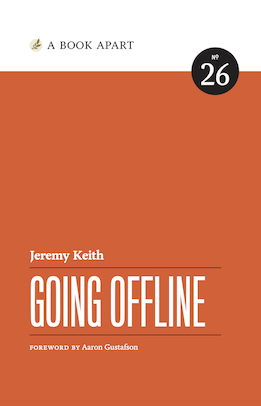Jeremy Keith's Blog, page 9
December 31, 2024
Words I wrote in 2024
People spent a lot of time and energy in 2024 talking about (and on) other people���s websites. Twitter. Bluesky. Mastodon. Even LinkedIn.
I observed it all with the dispassionate perspective of Dr. Manhattan on Mars. While I���m happy to see more people abondoning the cesspool that is Twitter, I���m not all that invested in either Mastodon or Bluesky. Or any other website, for that matter. I���m glad they���re there, but if they disappeared tomorrow, I���d carry on posting here on my own site.
I posted to my website over 850 times in 2024. sparkline
I shared over 350 links. sparkline
I posted over 400 notes. sparkline
I published just one article.
And I wrote almost 100 blog posts here in my journal this year. sparkline
Here are some cherry-picked highlights:
January: Continuous partial ick ��� Voigt-Kampff.March: What the world needs ��� Write for yourself.April: My approach to HTML web components ��� Naming custom elements, naming attributes, the single responsibility principle, and communicating across components.June: Filters ��� A web by humans, for humans.August: Frostapalooza ��� A truly special event.November: The meaning of ���AI�������� Naming things is hard, and sometimes harmful.December 30, 2024
Books I read in 2024
I���ve been keeping track of the books I���m reading for about seven years now. I do that here on my own website, as well as on bookshop.org.
It has become something of a tradition for me to post an end-of-year summary of the books I���ve read in the previous twelve months. Maybe I should be posting my thoughts on each book right after I finish it instead. Then again, I quite like the act of thinking about a book again after letting it sit and stew for a while.
I should probably stop including stars with these little reviews. They���re fairly pointless���pretty much everything I read is right down the middle in the ���good��� category. But to recap, here���s how I allocate my scores:
One star means a book is meh.Two stars means a book is perfectly fine.Three stars means a book is a good���consider it recommended.Four stars means a book is exceptional.Five stars is pretty much unheard of.No five-star books this year, but also no one-star books.
This year I read about 29 books. A bit of an increase on previous years, but the numbers can be deceptive���not every book is equal in length.
Fiction outnumbered non-fiction by quite a margin. I’m okay with that.
The Wager by David Grann“A tale of shipwreck, mutiny and murder” is promised on the cover and this book delivers. What’s astonishing is that it’s a true story. If it were fiction it would be dismissed as too far-fetched. It’s well told, and it’s surely only a matter of time before an ambitious film-maker takes on its Rashomon-like narrative.
���������������
Bridge by Lauren BeukesI think this might be Lauren’s best book since Zoo City. The many-worlds hypothesis has been mined to depletion in recent years but Bridge still manages to have a fresh take on it. The well-rounded characters ensure that you’re invested in the outcome.
���������������
The Penelopiad by Margaret AtwoodPart of my ongoing kick of reading retellings of Greek myths, this one focuses on a particularly cruel detail of Odysseus’s return.
���������������
Elektra by Jennifer SaintKeeping with the Greek retellings, this was the year that I read most of Jennifer Saint’s books. All good stuff, though I must admit that in my memory it’s all starting to blend together with other books like Costanza Casati’s Clytemnestra.
���������������
Children Of Memory by Adrian TchaikovskyThe final book in the trilogy, this doesn’t have the same wham-bam page-turning breathlessness as Children Of Time, but I have to say it’s really stuck with me. Whereas the previous books looked at the possibilities of biological intelligence (in spiders and octopuses), this one focuses inwards.
I don’t want to say anymore because I don’t want to spoil the culmination. I’ll just say that I think that by the end it posits a proposition that I don’t recall any other sci-fi work doing before.
Y’know what? Just because of how this one has lodged in my mind I’m going to give it an extra star.
���������������
Stone Blind by Natalie HaynesI think this is my favourite Natalie Haynes book so far. It also makes a great companion piece to another book I read later in the year���
���������������
The Great Hunger by Patrick KavanaghI picked up this little volume of poems when I was in Amsterdam���they go down surprisingly well with some strong beer and bitterballen. I was kind of blown away by how funny some of these vignettes were. There’s plenty of hardship too, but that’s the human condition for you.
���������������
Europe In Autumn, Europe At Midnight, Europe In Winter, and Europe At Dawn by Dave HutchinsonI read the Fractured Europe series throughout the year and thoroughly enjoyed it. I’ll readily admit that I didn’t always follow what was going on but that’s part of the appeal. The world-building is terrific. It’s an alternative version of a Brexity Europe that by the end of the first book starts to go in an unexpected direction. Jonathan Strange meets George Smiley.
���������������
The Odyssey by Homer translated by Robert FaglesSeeing as I’m reading all the modern retellings, it’s only fair that I have the source material to hand. This is my coffee table book that I dip into sporadically. I’ve got a copy of the prequel too.
I am not going to assign stars to this.
Faith, Hope and Carnage by Nick Cave and Se��n O���HaganFairly navel-gazing stuff, and you get the impression that Nick Cave thinks so too. Just as Neil Young would rather talk about his model trains, Nick Cave would rather discuss his pottery. The music stands on its own, but this is still better than most books about music.
���������������
Julia by Sandra NewmanNow this is an audacious move! Retelling 1984 from Julia’s perspective. Not only does it work, it also shines a light on some flaws in Orwell’s original (and I say that as someone who’s read everything Orwell ever wrote). I’m happy to say that the execution of this book matches its ambition.
���������������
Hamnet by Maggie O���FarrellSo if I’ve been reading alternative perspectives on Homer and Orwell, why not Shakespeare too? This is beautifully evocative and rich in detail. It’s also heartbreaking. A gorgeous work.
���������������
Pandora���s Jar: Women in the Greek Myths by Natalie HaynesI didn’t enjoy this as much as I enjoyed Natalie Hayne’s novels. It’s all good informative stuff, but it feels a bit like a collection of separate essays rather than a coherent piece.
���������������
Best Of British Science Fiction 2023 edited by Donna ScottI was lucky enough to get a pre-release copy of this from one of the authors. I love a good short story collection and this one is very good indeed.
���������������
Ithaca and House Of Odysseus by Claire NorthRemember how I said that some of the Greek retellings started to blend together? Well, no fear of that with this terrific series. Like Margaret Atwood’s retelling, Penelope is the main character here. Each book is narrated by a different deity, and yet there is little to no supernatural intervention. I’m really looking forward to reading the third and final book in the series.
���������������
The Shadow Of Perseus by Claire HeywoodThis is the one I was hinting at above that makes a great companion piece to Natalie Hayne’s Stone Blind. Two different���but equally sympathetic���takes on Medusa. This one is grittily earthbound���no gods here���and it’s a horrifying examination of toxic masculinity. And don’t expect any natural justice here.
���������������
Dogs Of War by Adrian TchaikovskyAdrian Tchaikovsky has a real knack for getting inside the animal mind. This story is smaller in scale than his Children Of Time series but it succeeds in telling its provocative tale snappily.
���������������
Reading 84K by Claire NorthI described Dave Hutchinson’s Fractured Europe series as Brexity, but this Claire North’s book is one that pushes Tory austerity to its dystopian logical conclusion. It’s all-too believable, if maybe a little over-long. Grim’n’good.
���������������
Ariadne by Jennifer SaintThe first of Jennifer Saint’s books is also my favourite. There’s a fantasically vivid description of the arrival of Dionysus into the narrative.
���������������
The Female Man by Joanna RussI’ve been meaning to read this one for years, but in the end I didn’t end up finishing it. That’s no slight on the book; I just wasn’t in the right frame of mind for it. I’m actually kind of proud of myself for putting a book down���I’m usually stubbornly completionist, which is stupid because life is too short. I hope to return to this at some future time.
Atalanta by Jennifer SaintAnother vividly-written tale by Jennifer Saint, but maybe suffers from trying to cram in all the varied accounts of Atalanta’s deeds and trials���the character’s motivations are hard to reconcile at different points.
���������������
Polostan by Neal StephensonThis was ���fine. It’s the first in a series called Bomb Light. Maybe I’ll appreciate it more in its final context. As a standalone work, there’s not quite enough there to carry it (including the cutesiness of making a young Richard Feynman a side character).
���������������
Tomorrow, and Tomorrow, and Tomorrow by Gabrielle ZevinThis too was ���fine. I know some people really love this, and maybe that raised my expectations, but in the end it was a perfectly good if unremarkable novel.
���������������
The Fates by Rosie GarlandPairs nicely with Jennifer Saint’s Atalanta. A decent yarn.
���������������
Earth Abides by George R. StewartI’ve just started this post-apocalyptic classic from 1949. Tune in next year to find out if I end up enjoying it.
Okay, so that was my reading for 2024. Nothing that completely blew me away but nothing that thoroughly disappointed me either. Plenty of good solid books. If I had to pick a favourite it would probably be Maggie Farrell’s Hamnet. And that Patrick Kavanagh collection of poems.
If you fancy going back in time, here are my previous round-ups:
Books I read in 2023,Books I read in 2022,Books I read in 2021,Books I read in 2020,Books I read in 2019,Books I read in 2018, andBooks I read in 2017.December 16, 2024
Choosing a geocoding provider
Yesterday when I mentioned my paranoia of third-party dependencies on The Session, I said:
I���ve built in the option to switch between multiple geocoding providers. When one of them inevitably starts enshittifying their service, I can quickly move on to another. It���s like having a ���go bag��� for geocoding.
(Geocoding, by the way, is when you provide a human-readable address and get back latitude and longitude coordinates.)
My paranoia is well-founded. I���ve been using Google���s geocoding API, which is changing its pricing model from next March.
You wouldn���t know it from the breathlessly excited emails they���ve been sending about it, but this is not a good change for me. I don���t do that much geocoding on The Session���around 13,000 or 14,000 requests a month. With the new pricing model that���ll be around $15 to $20 a month. Currently I slip by under the radar with the free tier.
So it might be time for me to flip that switch in my code. But which geocoding provider should I use?
There are plenty of slop-like listicles out there enumerating the various providers, but they���re mostly just regurgitating the marketing blurbs from the provider websites. What I need is more like a test kitchen.
Here���s what I did���
I took a representative sample of six recent additions to the sessions section of thesession.org. These examples represent places in the USA, Ireland, England, Scotland, Northern Ireland, and Spain, so a reasonable spread.
For each one of those sessions, I���m taking:
the venue name,the town name,the area name, andthe country.I���m deliberately not including the street address. Quite often people don���t bother including this information so I want to see how well the geocoding APIs cope without it.
I���ve scored the results on a simple scale of good, so-so, and just plain wrong.
A good result gets a score of one. This is when the result gives back an accurate street-level result.A so-so result gets a score of zero. This when it���s got the right coordinates for the town, but no more than that.A wrong result gets a score of minus one. This is when the result is like something from a large language model: very confident but untethered from reality, like claiming the address is in a completely different country. Being wrong is worse than being vague, hence the difference in scoring.Then I tot up those results for an overall score for each provider.
When I tried my six examples with twelve different geocoding providers, these were the results:
Geocoding providersProviderUSAEnglandIrelandSpainScotlandNorthern IrelandTotalGoogle1111117Mapquest1111117Geoapify0110103Here1101003Mapbox11011-13Bing1000001Nominatim0000-110OpenCage-11000-1-1Tom Tom-1-100-11-2Positionstack0-10-11-1-2Locationiq-10-100-1-3Map Maker-10-1-1-1-1-5Some interesting results there. I was surprised by how crap Bing is. I was also expecting better results from Mapbox.
Most interesting for me, Mapquest is right up there with Google.
So now that I���ve got a good scoring system, my next question is around pricing. If Google and Mapquest are roughly comparable in terms of accuracy, how would the pricing work out for each of them?
Let���s say I make 15,000 API requests a month. Under Google���s new pricing plan, that works out at $25. Not bad.
But if I���ve understood Mapquest���s pricing correctly, I reckon I���ll just squeek in under the free tier.
Looks like I���m flipping the switch to Mapquest.
If you���re shopping around for geocoding providers, I hope this is useful to you. But I don���t think you should just look at my results; they���re very specific to my needs. Come up with your own representative sample of tests and try putting the providers through their paces with your data.
If, for some reason, you want to see the terrible PHP code I���m using for geocoding on The Session, here it is.
December 15, 2024
Progressively enhancing maps
The Session has been online for over 20 years. When you maintain a site for that long, you don���t want to be relying on third parties���it���s only a matter of time until they���re no longer around.
Some third party APIs are unavoidable. The Session has maps for sessions and other events. When people add a new entry, they provide the address but then I need to get the latitude and longitude. So I have to use a third-party geocoding API.
My code is like a lesson in paranoia: I���ve built in the option to switch between multiple geocoding providers. When one of them inevitably starts enshittifying their service, I can quickly move on to another. It���s like having a ���go bag��� for geocoding.
Things are better on the client side. I���m using other people���s JavaScript libraries���like the brilliant abcjs���but at least I can self-host them.
I���m using Leaflet for embedding maps. It���s a great little library built on top of Open Street Map data.
A little while back I linked to a new project called OpenFreeMap. It���s a mapping provider where you even have the option of hosting the tiles yourself!
For now, I���m not self-hosting my map tiles (yet!), but I did want to switch to OpenFreeMap���s tiles. They���re vector-based rather than bitmap, so they���re lovely and crisp.
But there���s an issue.
I can use OpenFreeMap with Leaflet, but to do that I also have to use the MapLibre GL library. But whereas Leaflet is 148K of JavaScript, MapLibre GL is 800K! Yowzers!
That���s mahoosive by the standards of The Session���s performance budget. I���m not sure the loveliness of the vector maps is worth increasing the JavaScript payload by so much.
But this doesn���t have to be an either/or decision. I can use progressive enhancement to get the best of both worlds.
If you land straight on a map page on The Session for the first time, you���ll get the old-fashioned bitmap map tiles. There���s no MapLibre code.
But if you browse around The Session and then arrive on a map page, you���ll get the lovely vector maps.
Here���s what���s happening���
The maps are embedded using an HTML web component called embed-map. The fallback is a static image between the opening and closing tags. The web component then loads up Leaflet.
Here���s where the enhancement comes in. When the web component is initiated (in its connectedCallback method), it uses the Cache API to see if MapLibre has been stored in a cache. If it has, it loads that library:
caches.match('/path/to/maplibre-gl.js').then( responseFromCache => { if (responseFromCache) { // load maplibre-gl.js }});Then when it comes to drawing the map, I can check for the existence of the maplibreGL object. If it exists, I can use OpenFreeMap tiles. Otherwise I use the old Leaflet tiles.
But how does the MapLibre library end up in a cache? That���s thanks to the service worker script.
During the service worker���s install event, I give it a list of static files to cache: CSS, JavaScript, and so on. That includes third-party libraries like abcjs, Leaflet, and now MapLibre GL.
Crucially this caching happens off the main thread. It happens in the background and it won���t slow down the loading of whatever page is currently being displayed.
That���s it. If the service worker installation works as planned, you���ll get the nice new vector maps. If anything goes wrong, you���ll get the older version.
By the way, it���s always a good idea to use a service worker and the Cache API to store your JavaScript files. As you know, JavaScript is unduly expensive to performance; not only does the JavaScript file have to be downloaded, it then has to be parsed and compiled. But JavaScript stored in a cache during a service worker���s install event is already parsed and compiled.
December 4, 2024
Cocolingo
This year I decided I wanted to get better at speaking Irish.
Like everyone brought up in Ireland, I sort of learned the Irish language in school. It was a compulsory subject, along with English and maths.
But Irish wasn���t really taught like a living conversational language. It was all about learning enough to pass the test. Besides, if there���s one thing that���s guaranteed to put me off something, it���s making it compulsory.
So for the first couple of decades of my life, I had no real interest in the Irish language, just as I had no real interest in traditional Irish music. They were both tainted by some dodgy political associations. They were both distinctly uncool.
But now? Well, Irish traditional music rules my life. And I���ve come to appreciate the Irish language as a beautiful expressive thing.
I joined a WhatsApp group for Irish language learners here in Brighton. The idea is that we���d get together to attempt some converstation as Gaeilge but we���re pretty lax about actually doing that.
Then there���s Duolingo. I started ���playing? doing? Not sure what the verb is.
Duolingo is a bit of a mixed bag. I think it works pretty well for vocabulary acquisition. But it���s less useful for grammar. I was glad that I had some rudiments of Irish from school or I would���ve been completely lost.
Duolingo will tell you what the words are, but it never tells you why. For that I���m going to have to knuckle down with some Irish grammar books, videos, or tutors.
Duolingo is famous for its gamification. It mostly worked on me. I had to consciously remind myself sometimes that the purpose was to get better at Irish, not to score more points and ascend a league table.
Oh, did I ascend that league table!
But I can���t take all the credit. That must go to Coco, the cat.
It���s not that Coco is particularly linguistically gifted. Quite the opposite. She never says a word. But she did introduce a routine that lent itself to doing Duolingo every day.
Coco is not our cat. But she makes herself at home here, for which we feel inordinately honoured.
Coco uses our cat flap to come into the house pretty much every morning. Then she patiently waits for one of us to get up. I���m usually up first, so I���m the one who gives Coco what she wants. I go into the living room and sit on the sofa. Coco then climbs on my lap.
It���s a lovely way to start the day.
But of course I can���t just sit there alone with my own thoughts and a cat. I���ve got to do something. So rather than starting the day with some doomscrolling, I start with some Irish on Duolingo.
After an eleven-month streak, something interesting happened; I finished.
I���m not used to things on the internet having an end. Had I been learning a more popular language I���m sure there would���ve been many more lessons. But Irish has a limited lesson plan.
Of course the Duolingo app doesn���t say ���You did it! You can delete the app now!��� It tries to get me to do refresher exercises, but we both know that there are diminishing returns and we���d just be going through the motions. It���s time for us to part ways.
I���ve started seeing other apps. Mango is really good so far. It helps that they���ve made some minority languages available for free, Irish included.
I���m also watching programmes on TG4, the Irish language television station that has just about everything in its schedule available online for free anywhere in the world. I can���t bring myself to get stuck into Ros na R��n, the trashy Irish language soap opera, but I have no problem binging on CR��, the gritty Donegal crime drama.
There are English subtitles available for just about everything on TG4. I wish that Irish subtitles were also available���it���s really handy to hear and read Irish at the same time���but only a few shows offer that, like the kid���s cartoon L�� Ban.
Oh, and I���ve currently got a book on Irish grammar checked out of the local library. So now when Coco comes to visit in the morning, she can keep me company while I try to learn from that.
November 28, 2024
Going Offline is online ���for free
I wrote a book about service workers. It���s called Going Offline. It was first published by A Book Apart in 2018. Now it���s available to read for free online.
If you want you can read the book as a PDF, an ePub, or .mobi, but I recommend reading it in your browser.
Needless to say the web book works offline. Once you go to goingoffline.adactio.com you can add it to the homescreen of your mobile device or add it to the dock on your Mac. After that, you won���t need a network connection.
The book is free to read. Properly free. Not the kind of ���free��� where you have to supply an email address first. Why would I make you go to the trouble of generating a burner email account?
The site has no analytics. No tracking. No third-party scripts of any kind whatsover. By complete coincidence, the site is fast. Funny that.
For the styling of this web book, I tweaked the stylesheet I used for HTML5 For Web Designers. I updated it a little bit to use logical properties, some fluid typography and view transitions.
In the process of converting the book to HTML, I got reaquainted with what I had written almost seven years ago. It was kind of fun to approach it afresh. I think it stands up pretty darn well.
Ethan wrote about his feelings when he put two of his books online, illustrated by that amazing photo that always gives me the feels:
I���ll miss those days, but I���m just glad these books are still here. They���re just different than they used to be. I suppose I am too.
Anyway, if you���re interested in making your website work offline, have a read of Going Offline. Enjoy!
November 24, 2024
Syndicating to Bluesky
Last year I described how I syndicate my posts to different social networks.
Back then my approach to syndicating to Bluesky was to piggy-back off my micro.blog account (which is really just the RSS feed of my notes):
Micro.blog can also cross-post to other services. One of those services is Bluesky. I gave permission to micro.blog to syndicate to Bluesky so now my notes show up there too.
It worked well enough, but it wasn���t real-time and I didn���t have much control over the formatting. As Bluesky is having quite a moment right now, I decided to upgrade my syndication strategy and use the Bluesky API.
Here���s how it works���
First you need to generate an app password. You���ll need this so that you can generate a token. You need the token so you can generate ���just kidding; the chain of generated gobbledegook stops there.
Here���s the PHP I���m using to generate a token. You���ll need your Bluesky handle and the app password you generated.
Now that I���ve got a token, I can send a post. Here���s the PHP I���m using.
There���s something extra code in there to spot URLs and turn them into links. Bluesky has a very weird way of doing this.
It didn���t take too long to get posting working. After some more tinkering I got images working too. Now I can post straight from my website to my Bluesky profile. The Bluesky API returns an ID for the post that I���ve created there so I can link to it from the canonical post here on my website.
I���ve updated my posting interface to add a toggle for Bluesky right alongside the toggle for Mastodon. There used to be a toggle for Twitter. That���s long gone.
Now when I post a note to my website, I can choose if I want to send a copy to Mastodon or Bluesky or both.
One day Bluesky will go away. It won���t matter much to me. My website will still be here.
November 12, 2024
The meaning of ���AI���
There are different kinds of buzzwords.
Some buzzwords are useful. They take a concept that would otherwise require a sentence of explanation and package it up into a single word or phrase. Back in the day, ���ajax��� was a pretty good buzzword.
Some buzzwords are worse than useless. This is when a word or phrase lacks definition. You could say this buzzword in a meeting with five people, and they���d all understand five different meanings. Back in the day, ���web 2.0��� was a classic example of a bad buzzword���for some people it meant a business model; for others it meant rounded corners and gradients.
The worst kind of buzzwords are the ones that actively set out to obfuscate any actual meaning. ���The cloud��� is a classic example. It sounds cooler than saying ���a server in Virginia���, but it also sounds like the exact opposite of what it actually is. Great for marketing. Terrible for understanding.
���AI��� is definitely not a good buzzword. But I can���t quite decide if it���s merely a bad buzzword like ���web 2.0��� or a truly terrible buzzword like ���the cloud���.
The biggest problem with the phrase ���AI��� is that there���s a name collision.
For years, the term ���AI��� has been used in science-fiction. HAL 9000. Skynet. Examples of artificial general intelligence.
Now the term ���AI��� is also used to describe large language models. But there is no connection between this use of the term ���AI��� and the science fictional usage.
This leads to the ludicrous situation of otherwise-rational people wanted to discuss the dangers of ���AI���, but instead of talking about the rampant exploitation and energy usage endemic to current large language models, they want to spend the time talking about the sci-fi scenarios of runaway ���AI���.
To understand how ridiculous this is, I���d like you to imagine if we had started using a different buzzword in another setting���
Suppose that when ride-sharing companies like Uber and Lyft were starting out, they had decided to label their services as Time Travel. From a marketing point of view, it even makes sense���they get you from point A to point B lickety-split.
Now imagine if otherwise-sensible people began to sound the alarm about the potential harms of Time Travel. Given the explosive growth we���ve seen in this sector, sooner or later they���ll be able to get you to point B before you���ve even left point A. There could be terrible consequences from that���we���ve all seen the sci-fi scenarios where this happens.
Meanwhile the actual present-day harms of ride-sharing services around worker exploitation would be relegated to the sidelines. Clearly that isn���t as important as the existential threat posed by Time Travel.
It sounds ludicrous, right? It defies common sense. Just because a vehicle can get you somewhere fast today doesn���t mean it���s inevitably going to be able to break the laws of physics any day now, simply because it���s called Time Travel.
And yet that is exactly the nonsense we���re being fed about large language models. We call them ���AI���, we look at how much they can do today, and we draw a straight line to what we know of ���AI��� in our science fiction.
This ridiculous situation could���ve been avoided if we had settled on a more accurate buzzword like ���applied statistics��� instead of ���AI���.
It���s almost as if the labelling of the current technologies was more about marketing than accuracy.
November 10, 2024
FFConf 2024
I went to FFConf on Friday. It did me the world of good.
To be honest, I haven���t much felt like venturing out over the past few days since my optimism took a big hit. But then when I do go and interact with people, I���m grateful for it.
Like, when I went out to my usual Wednesday evening traditional Irish music session I was prepared the inevitable discussion of Trump���s election. I was ready to quite clearly let people know that I didn���t want to talk about it. But I didn���t have to. Maybe because everyone else was feeling much the same, we just played and played. It was good.
The session on Thursday was good too. When we chatted, it was about music.
Still, I was ready for the weekend and I wasn���t really feeling psyched up for FFConf on Friday. But once I got there, I was immediately uplifted.
It was so nice to see so many people I hadn���t seen in quite a while. I had the chance to reconnect with people that I had only been hearing from through my RSS reader:
���Terence, I���m really enjoying your sci-fi short stories!���
���Kirsty, I was on tenterhooks when you were getting Mabel!���
(Mabel is an adorable kitty-cat. In hindsight I probably should���ve also congratulated her on getting married. To a human.)
The talks were really good this year. They covered a wide variety of topics.
There was only one talk about ���AI��� (unlike most conferences these days, where it dominates the agenda). L��onie gave a superb run-down of the different kinds of machine learning and how they can help or hinder accessibility.
Crucially, L��onie began her talk by directly referencing the exploitation and energy consumption inherent in today���s large language models. It took all of two minutes, but it was two minutes more than the whole day of talks at UX Brighton. Thank you, L��onie!
Some of the other talks covered big topics. Life. Death. Meaning. Purpose.
I enjoyed them all, though I often find something missing from discussions about meaning and purpose. Just about everyone agrees that having a life enfused with purpose is what provides meaning. So there���s an understandable quest to seek out what it is that gives you purpose.
But we���re also constantly reminded that every life has intrinsic meaning. ���You are enough���, not ���you are enough, as long as there���s some purpose to your life.���
I found myself thinking about Winne Lim���s great post on leading a purposeless life. I think about it a lot. It gives me comfort. Instead of assuming that your purpose is out there somewhere and you���ve got to find it, you can entertain the possibility that your life might not have a purpose ���and that���s okay.
I know this all sounds like very heavy stuff, but it felt good to be in a room full of good people grappling with these kind of topics. I needed it.
Dare I say it, perhaps my optimism is returning.
Jeremy Keith's Blog
- Jeremy Keith's profile
- 56 followers
















